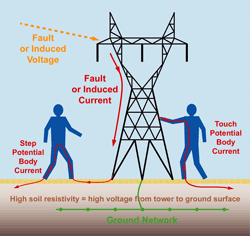What is Step and Touch Potential?
Whitepaper
Step and Touch Potential Awareness: Improving Transmission Line Crew Safety
Read Whitepaper
Articles
Protect Yourself From Induced Current - Powerlineman Magazine
Read article
Beware Grounding of Vehicles and Equipment - Powerlineman Magazine
Read article
Protective Bonding and Grounding for Line Crews - Powerlineman Magazine
Read article
Awareness of step and touch potential, caused by ground potential rise, is important for anyone working on high-voltage power transmission systems. In a typical SNT application, the transmission line is de-energized and is bonded to the tower to be safe to work on. However, the transmission line itself acts as a very large antenna, and can pick up large amounts of energy which must be shunted to earth ground. And if the tower ground is faulty, the ground potential may rise and a dangerous condition can result.
Step Potential: Voltage between the feet of a person

When current is flowing from the tower to the earth ground, the ground potential rises at the tower and a voltage gradient will occur based on the resistivity of the soil, resulting in a potential difference between two points on the ground. This is called a Step Potential as it can cause voltage between a person’s feet.
Touch Potential: Voltage between energized object and feet of a person
If the ground connection between the tower and the soil is high resistance (common with some soil conditions), the tower itself (and any conductive item touching the tower) can be energized. Touch potential is the voltage between the energized object and the feet of a person in contact with the object.
Monitoring Step and Touch Potential with the SNT
As power transmission systems become increasingly complex and power corridors crowded, it becomes more common for parallel energized lines to couple energy (via electromagnetic induction) to de-energized lines. Further, with the sophisticated power control needed to manage green energy, power levels on various lines can vary dramatically during a work shift.
The SNT-02 kit provides an easy-to-use method to continuously monitor and alarm step-and-touch potential. Simply drive the special ground rod about 15 feet from the tower, mount the instrument and connect the probe to the tower using a standard hot stick.
| Common Practice | Better Practice |
|---|---|
| Measure step and touch potential before beginning work. | Measure step and touch potential before and continuously during work. |
| Use a voltage meter to measure potential. | Use the SNT to monitor and alarm the potential. |
